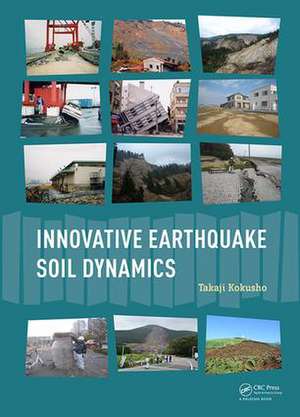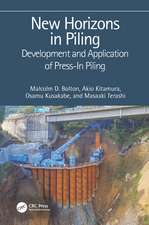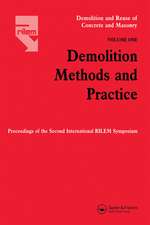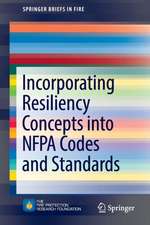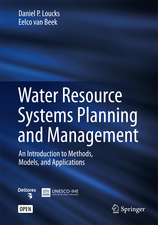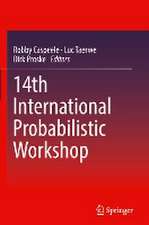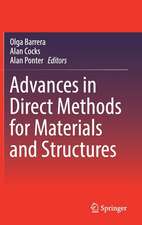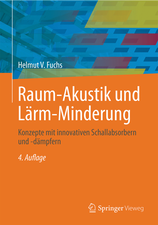Innovative Earthquake Soil Dynamics
Autor Takaji Kokushoen Limba Engleză Hardback – 27 iul 2017
Major topics are (i) seismic site amplification, (ii) liquefaction and (iii) earthquake-induced slope failure. Associated with the above, basic theories and knowledge on wave propagation/attenuation, soil properties, laboratory tests, numerical analyses, and model tests are addressed in the first part of the book. A great number of earthquake observations in surface soil deposits as well as case histories with new findings are addressed in the later chapters, together with associated laboratory test data. Most of the research results originate from Japan, which is rich in earthquake records and case histories, although mostly isolated from the outside world because of the language barrier.
Another important feature characterizing this book is an energy perspective in addition to the force-equilibrium perspective, because it is the author’s strong belief that energy is a very relevant index in determining seismic failures, particularly of soils and soil structures.
Innovative Earthquake Soil Dynamics is written for international readers, graduate students, researchers, and practicing engineers, interested in this field.
| Toate formatele și edițiile | Preț | Express |
|---|---|---|
| Paperback (1) | 451.54 lei 6-8 săpt. | |
| CRC Press – 30 iun 2020 | 451.54 lei 6-8 săpt. | |
| Hardback (1) | 886.37 lei 6-8 săpt. | |
| CRC Press – 27 iul 2017 | 886.37 lei 6-8 săpt. |
Preț: 886.37 lei
Preț vechi: 1184.48 lei
-25% Nou
Puncte Express: 1330
Preț estimativ în valută:
169.63€ • 184.19$ • 142.49£
169.63€ • 184.19$ • 142.49£
Carte tipărită la comandă
Livrare economică 22 aprilie-06 mai
Preluare comenzi: 021 569.72.76
Specificații
ISBN-13: 9781138029026
ISBN-10: 1138029025
Pagini: 506
Dimensiuni: 174 x 246 x 34 mm
Greutate: 1.05 kg
Ediția:1
Editura: CRC Press
Colecția CRC Press
Locul publicării:Boca Raton, United States
ISBN-10: 1138029025
Pagini: 506
Dimensiuni: 174 x 246 x 34 mm
Greutate: 1.05 kg
Ediția:1
Editura: CRC Press
Colecția CRC Press
Locul publicării:Boca Raton, United States
Public țintă
Postgraduate and ProfessionalCuprins
Preface
Chapter 1. Elastic wave propagation in soil
1.1. Introduction
1.2. One-dimensional wave propagation and wave energy
1.3. Three-dimensional body waves
1.4. Surface waves
1.5. Viscoelastic model and soil damping for wave propagation
1.6. Wave attenuation by internal damping
1.7. Wave attenuation including geometric damping
1.8. Summary
Chapter 2. Soil properties during earthquakes
2.1. Characterization of dynamic soil properties
2.2. How to measure soil properties
2.3. Typical small strain properties
2.4. Strain-dependent equivalent linear properties
2.5. Summary
Chapter 3. Soil modeling for dynamic analysis and scaled model test
3.1. Modeling of soil properties
3.2. Dynamic soil analyses
3.3. Scaled model tests and soil model
3.4. Summary
Chapter 4. Seismic site amplification and wave energy
4.1. Soil condition and site amplification
4.2. Amplification in two-layer system
4.3. Site amplification by earthquake observation
4.4. Site amplification derived from vertical array records
4.5. SSI and radiation damping in one-dimensional wave propagation
4.6. Energy flow in wave propagation
4.7. Summary
Chapter 5. Liquefaction
5.1. Typical Liquefaction Behavior
5.2. General conditions for liquefaction triggering
5.3. Geotechnical conditions for liquefaction triggering
5.4. Effect of gravels and fines
5.5. Liquefaction potential evaluation by in situ tests
5.6. Energy-based liquefaction potential evaluation
5.7. Effect of incomplete saturation
5.8. Effect of initial shear stress
5.9. Cyclic softening of clayey soils
5.10. Liquefaction-induced failure and associated mechanism
5.11. Base-isolation during liquefaction
5.12. Summary
Chapter 6. Earthquake-induced slope failures
6.1. Slip-surface analysis by seismic coefficient
6.2. Newmark method
6.3. Self-weight deformation analysis using degraded moduli
6.4. Energy-based slope failure evaluation
6.5. Case histories and back-calculations by energy-based method
6.6. Summary
Chapter 1. Elastic wave propagation in soil
1.1. Introduction
1.2. One-dimensional wave propagation and wave energy
1.3. Three-dimensional body waves
1.4. Surface waves
1.5. Viscoelastic model and soil damping for wave propagation
1.6. Wave attenuation by internal damping
1.7. Wave attenuation including geometric damping
1.8. Summary
Chapter 2. Soil properties during earthquakes
2.1. Characterization of dynamic soil properties
2.2. How to measure soil properties
2.3. Typical small strain properties
2.4. Strain-dependent equivalent linear properties
2.5. Summary
Chapter 3. Soil modeling for dynamic analysis and scaled model test
3.1. Modeling of soil properties
3.2. Dynamic soil analyses
3.3. Scaled model tests and soil model
3.4. Summary
Chapter 4. Seismic site amplification and wave energy
4.1. Soil condition and site amplification
4.2. Amplification in two-layer system
4.3. Site amplification by earthquake observation
4.4. Site amplification derived from vertical array records
4.5. SSI and radiation damping in one-dimensional wave propagation
4.6. Energy flow in wave propagation
4.7. Summary
Chapter 5. Liquefaction
5.1. Typical Liquefaction Behavior
5.2. General conditions for liquefaction triggering
5.3. Geotechnical conditions for liquefaction triggering
5.4. Effect of gravels and fines
5.5. Liquefaction potential evaluation by in situ tests
5.6. Energy-based liquefaction potential evaluation
5.7. Effect of incomplete saturation
5.8. Effect of initial shear stress
5.9. Cyclic softening of clayey soils
5.10. Liquefaction-induced failure and associated mechanism
5.11. Base-isolation during liquefaction
5.12. Summary
Chapter 6. Earthquake-induced slope failures
6.1. Slip-surface analysis by seismic coefficient
6.2. Newmark method
6.3. Self-weight deformation analysis using degraded moduli
6.4. Energy-based slope failure evaluation
6.5. Case histories and back-calculations by energy-based method
6.6. Summary
Recenzii
"The book Innovative Earthquake Soil Dynamics is very appropriately titled and reflects the unique background and extensive expertise of the author, Dr. Takaji Kokusho, Emeritus Professor, Chuo University, Tokyo, Japan. The book is composed of six chapters that can be grouped into four categories: background material (Chapters 1-3), site amplification and dynamic soil-structure-interaction (Chapter 4), liquefaction and related phenomena (Chapter 5), and earthquake-induced slope failure (Chapter 6). The background material presented in Chapters 1-3 gives an in depth coverage of elastic wave propagation in soil, dynamic soil properties, and soil modeling and sets the stage for the topics covered in the latter chapters.
Innovative Earthquake Soil Dynamics is unique from other books on geotechnical aspects of earthquake engineering in that it includes a detailed coverage of soil dynamics, as related to earthquake engineering, in addition to the oft-presented empirical relationships. The book is innovative in that it presents the material from both "traditional" (e.g., stress-, strain-, and force-based perspectives) and "energy" perspectives, with the latter largely derived from the author’s own extensive research. The author shows that energy is central to site amplification and dynamic soil-structure-interaction and can be used as a simple index for evaluating liquefaction and related phenomena and earthquake-induced slope failures.
Another unique aspect of Innovative Earthquake Soil Dynamics stems from the author having received his higher education in both the United States (Duke University) and Japan (University of Tokyo), and having spent the first half of his career working for the electric power industry in Japan and the second half of his career as a professor at Chuo University. As a result, the material presented in the book reflects research and engineering procedures from both Japan and the United States, as well as other countries, and all the material presented builds to applications in engineering practice. The book is equally suited to serve as a text for graduate courses in geotechnical aspects of earthquake engineering and soil dynamics or as a reference book for practicing engineers."
Russell A. Green, Professor of Civil and Environmental Engineering at Virginia Tech, Blacksburg, Virginia, USA.
Innovative Earthquake Soil Dynamics is unique from other books on geotechnical aspects of earthquake engineering in that it includes a detailed coverage of soil dynamics, as related to earthquake engineering, in addition to the oft-presented empirical relationships. The book is innovative in that it presents the material from both "traditional" (e.g., stress-, strain-, and force-based perspectives) and "energy" perspectives, with the latter largely derived from the author’s own extensive research. The author shows that energy is central to site amplification and dynamic soil-structure-interaction and can be used as a simple index for evaluating liquefaction and related phenomena and earthquake-induced slope failures.
Another unique aspect of Innovative Earthquake Soil Dynamics stems from the author having received his higher education in both the United States (Duke University) and Japan (University of Tokyo), and having spent the first half of his career working for the electric power industry in Japan and the second half of his career as a professor at Chuo University. As a result, the material presented in the book reflects research and engineering procedures from both Japan and the United States, as well as other countries, and all the material presented builds to applications in engineering practice. The book is equally suited to serve as a text for graduate courses in geotechnical aspects of earthquake engineering and soil dynamics or as a reference book for practicing engineers."
Russell A. Green, Professor of Civil and Environmental Engineering at Virginia Tech, Blacksburg, Virginia, USA.
Descriere
This book deals with all aspects of soil behavior from the bedrock up to the ground surface necessary for engineering design of structures, wherein generally accepted basic knowledge as well as advanced and innovative views are accommodated. Major topics discussed in this book of earthquake geotechnical engineering are (i) seismic site amplification, (ii) liquefaction, and (iii) earthquake-induced slope failure. Basic theories and methodologies on wave propagation/attenuation, soil properties, laboratory tests, numerical analyses, and model tests are addressed in the earlier chapters. It is written for an international audience of graduate students, researchers and practicing engineers.
